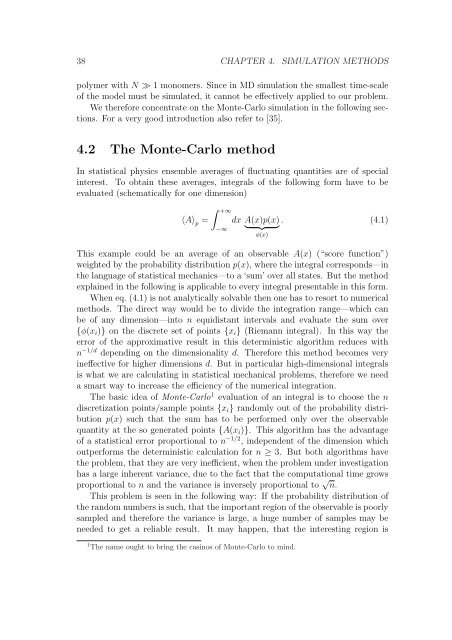Polymers in Confined Geometry.pdf
Polymers in Confined Geometry.pdf
Polymers in Confined Geometry.pdf
Create successful ePaper yourself
Turn your PDF publications into a flip-book with our unique Google optimized e-Paper software.
38 CHAPTER 4. SIMULATION METHODS<br />
polymer with N ≫ 1 monomers. S<strong>in</strong>ce <strong>in</strong> MD simulation the smallest time-scale<br />
of the model must be simulated, it cannot be effectively applied to our problem.<br />
We therefore concentrate on the Monte-Carlo simulation <strong>in</strong> the follow<strong>in</strong>g sections.<br />
For a very good <strong>in</strong>troduction also refer to [35].<br />
4.2 The Monte-Carlo method<br />
In statistical physics ensemble averages of fluctuat<strong>in</strong>g quantities are of special<br />
<strong>in</strong>terest. To obta<strong>in</strong> these averages, <strong>in</strong>tegrals of the follow<strong>in</strong>g form have to be<br />
evaluated (schematically for one dimension)<br />
〈A〉 p =<br />
+∞<br />
−∞<br />
dx A(x)p(x) . (4.1)<br />
<br />
φ(x)<br />
This example could be an average of an observable A(x) (“score function”)<br />
weighted by the probability distribution p(x), where the <strong>in</strong>tegral corresponds—<strong>in</strong><br />
the language of statistical mechanics—to a ‘sum’ over all states. But the method<br />
expla<strong>in</strong>ed <strong>in</strong> the follow<strong>in</strong>g is applicable to every <strong>in</strong>tegral presentable <strong>in</strong> this form.<br />
When eq. (4.1) is not analytically solvable then one has to resort to numerical<br />
methods. The direct way would be to divide the <strong>in</strong>tegration range—which can<br />
be of any dimension—<strong>in</strong>to n equidistant <strong>in</strong>tervals and evaluate the sum over<br />
{φ(xi)} on the discrete set of po<strong>in</strong>ts {xi} (Riemann <strong>in</strong>tegral). In this way the<br />
error of the approximative result <strong>in</strong> this determ<strong>in</strong>istic algorithm reduces with<br />
n −1/d depend<strong>in</strong>g on the dimensionality d. Therefore this method becomes very<br />
<strong>in</strong>effective for higher dimensions d. But <strong>in</strong> particular high-dimensional <strong>in</strong>tegrals<br />
is what we are calculat<strong>in</strong>g <strong>in</strong> statistical mechanical problems, therefore we need<br />
a smart way to <strong>in</strong>crease the efficiency of the numerical <strong>in</strong>tegration.<br />
The basic idea of Monte-Carlo 1 evaluation of an <strong>in</strong>tegral is to choose the n<br />
discretization po<strong>in</strong>ts/sample po<strong>in</strong>ts {xi} randomly out of the probability distribution<br />
p(x) such that the sum has to be performed only over the observable<br />
quantity at the so generated po<strong>in</strong>ts {A(xi)}. This algorithm has the advantage<br />
of a statistical error proportional to n −1/2 , <strong>in</strong>dependent of the dimension which<br />
outperforms the determ<strong>in</strong>istic calculation for n ≥ 3. But both algorithms have<br />
the problem, that they are very <strong>in</strong>efficient, when the problem under <strong>in</strong>vestigation<br />
has a large <strong>in</strong>herent variance, due to the fact that the computational time grows<br />
proportional to n and the variance is <strong>in</strong>versely proportional to √ n.<br />
This problem is seen <strong>in</strong> the follow<strong>in</strong>g way: If the probability distribution of<br />
the random numbers is such, that the important region of the observable is poorly<br />
sampled and therefore the variance is large, a huge number of samples may be<br />
needed to get a reliable result. It may happen, that the <strong>in</strong>terest<strong>in</strong>g region is<br />
1 The name ought to br<strong>in</strong>g the cas<strong>in</strong>os of Monte-Carlo to m<strong>in</strong>d.













